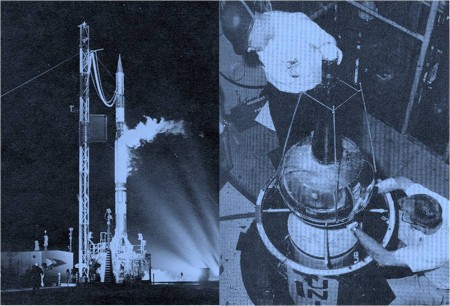Fifty-three years ago this month, the Vanguard III scientific satellite was successfully launched into Earth orbit by a 3-stage Vanguard Satellite Launch Vehicle (SLV). The last of the pioneering Vanguard satellite series, Vanguard 3 made lasting contributions to the fields of earth science, space physics and satellite technology.
Project Vanguard was a United States satellite launching program that began in 1955. The primary goal was to orbit the nation’s first satellite during the International Geophysical Year (IGY) covering the period from 01 Jul 1957 to 31 December 1958. The Naval Research Laboratory (NRL) had overall technical responsibility for Project Vanguard.
Due to Cold War tensions, the Eisenhower Administration wanted to orbit a scientific satellite using a non-military launch vehicle. Thus, Project Vanguard was tasked with developing both a satellite and a companion launch vehicle. The latter, known as the Vanguard Satellite Launch Vehicle (SLV), was based on the Viking sounding rocket. The 3-stage Vanguard SLV was capable of orbiting an artificial satellite with a maximum weight of 50-lbs.
Vanguard I, weighing a mere 3 lbs, was successfully launched into orbit on Monday, 17 March 1958. While it was the first Vanguard satellite to achieve orbit, it was not the first American satellite. That distinction went to Explorer I, which was launched several weeks earlier on Friday, 31 January 1958. The primary mission of Vanguard I was quite basic in that its purpose was to determine the effects of the space environment on the primitive satellite and its systems.
Vanguard II successfully reached orbit on Tuesday, 17 February 1959. The 23-lb spherical satellite investigated cloud cover patterns in the Earth’s atmosphere during the daylight portion of each orbital pass. Vanguard II also helped to determine the mass density of the upper atmosphere as a function of altitude, latitude, season, and solar activity.
Vanguard III was launched from Cape Canaveral, Florida on Friday, 18 September 1959. Lift-off of the Vanguard SLV-7 from LC-18A occurred at 05:16:00 UTC. The 50-lb satellite was placed into a highly elliptical orbit measuring 1842-nm (apogee) by 276-nm (perigee). The third stage failed to separate from the satellite as planned. However, the effects of such on mission performance were minimal.
Over its 84-day mission period, Vanguard III mapped the magnetic field of the Earth at altitudes between apogee and perigee for latitudes between plus and minus 33 degrees. A micrometeroid detector recorded more than 6,500 impacts in orbit during a sample period of 66 days. Onboard sensors were also employed to measure the X-ray radiation emitted by the Sun and the effects that this radiation had on our atmosphere.
Like its predecessor, the Vanguard III satellite was used to determine the variation of upper atmosphere density with altitude, latitude, season and solar activity. Data were also obtained on the effects of atmospheric drag on orbital altitude decay. On Friday, 11 December 1959, transmission of data from Vanguard III ceased.
Vanguard III was the last Vanguard satellite to be orbited. From a programmatic standpoint, success did not come easy. Indeed, out of eleven (11) launches, only three (3) Vanguard satellites achieved orbit. However, the Vanguard Program’s pioneering contributions to satellite design, launch vehicle development, space tracking, spaceflight technology, earth sciences and space physics were significant.
As of this writing, the trio of Vanguard satellites launched back in the late 1950’s are still in orbit. While the first satellites (the Soviet Union’s Sputnik I and the United States Explorer I) fell out of orbit long ago, Vanguard III is expected to remain in orbit for another 250 years.


